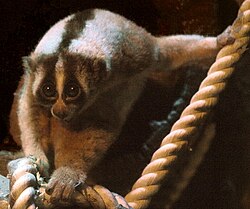Portal:Primates
The Primates Portal A primate is a member of the biological order Primates, the group that contains lemurs, the aye-aye, lorisids, galagos, tarsiers, monkeys, and apes, with the last category including great apes. With the exception of humans, who inhabit every continent on Earth, most primates live in tropical or subtropical regions of the Americas, Africa and Asia. Primates range in size from the 30-gram (1 oz) pygmy mouse lemur to the 200-kilogram (440 lb) mountain gorilla. According to fossil evidence, the primitive ancestors of primates may have existed in the late Cretaceous period around 65 mya (million years ago), and the oldest known primate is the Late Paleocene Plesiadapis, c. 55–58 mya. Molecular clock studies suggest that the primate branch may be even older, originating in the mid-Cretaceous period around 85 mya. Primates exhibit a wide range of characteristics. Some primates do not live primarily in trees, but all species possess adaptations for climbing trees. Locomotion techniques used include leaping from tree to tree, walking on two or four limbs, knuckle-walking, and swinging between branches of trees (known as brachiation). Primates are characterized by their large brains relative to other mammals. These features are most significant in monkeys and apes, and noticeably less so in lorises and lemurs. Many species are sexually dimorphic, which means males and females have different physical traits, including body mass, canine tooth size, and coloration.
Selected articleLemurs of Madagascar, currently in its third edition, is a reference work and field guide for the lemurs of Madagascar, giving descriptions and biogeographic data for the known species. The primary contributor is Russell Mittermeier, president of Conservation International, and the cover art and illustrations were drawn by Stephen D. Nash. The book provides details about all known lemur species, general information about lemurs and their history, and also helps travelers identify species they may encounter. Four related pocket field guides have also been released, containing color illustrations of each species, miniature range maps, and species checklists. The first edition was reviewed favorably in the International Journal of Primatology, Conservation Biology, and Lemur News. Reviewers, including Alison Jolly, praised the book for its meticulous coverage of each species, numerous high-quality illustrations, and engaging discussion of lemur topics, including conservation, evolution, and the recently extinct subfossil lemurs. Each agreed that the book was an excellent resource for a wide audience, including ecotourists and lemur researchers. A lengthy review of the second edition was published in the American Journal of Primatology, where it received similar favorable comments, plus praise for its updates and enhancements. The third edition was reviewed favorably in Lemur News; the reviewer praised the expanded content of the book, but was concerned that the edition was not as portable as its predecessors. The first edition identified 50 lemur species and subspecies, compared to 71 in the second edition and 101 in the third. The taxonomy promoted by these books has been questioned by researchers, such as Ian Tattersall, who view these growing numbers of lemur species as insufficiently justified inflation of species numbers (taxonomic inflation). Selected picture A Barbary macaque (Macaca sylvanus) by the Upper Rock Nature Reserve in Gibraltar. Although the species is commonly referred to as the "Barbary ape", it is in fact a monkey. The Barbary macaque population in Gibraltar is the last in the whole of the European continent. A popular belief holds that as long as Barbary macaques exist on Gibraltar, the territory will remain under British rule. CategoriesSelected species Endangered (IUCN 3.1)|Endangered The Javan slow loris (Nycticebus javanicus) is a strepsirrhine primate and a species of slow loris native to the western and central portions of the island of Java, in Indonesia. For many years, it was considered a subspecies of the Sunda slow loris (N. coucang), until the 2000s when it was promoted to full species status. It is most closely related to the Sunda slow loris and the Bengal slow loris (N. bengalensis). The species has two forms, based on hair length and, to a lesser extent, coloration. Its forehead has a prominent white diamond pattern, which is formed by a distinct stripe that runs over its head and forks towards the eyes and ears. The Javan slow loris weighs between 565–687 g (1.25–1.51 lb) and has a head-body length of about 293 mm (11.5 in). Like all lorises, it is arboreal and moves slowly across vines and lianas instead of jumping from tree to tree. Its diet typically consists of fruit, tree gum, lizards and eggs. It sleeps on exposed branches, sometimes in groups, and is usually seen alone or in pairs. The Javan slow loris population is in sharp decline due to poaching for the exotic pet trade. It is also used in research associated with traditional medicine. Remaining populations have low densities, and habitat loss is a major threat. For these reasons, the International Union for Conservation of Nature (IUCN) lists its status as "endangered," and it has also been included on the 2008–2010 list of "The World's 25 Most Endangered Primates." It is protected by Indonesian law and, since June 2007, is listed under CITES Appendix I. Despite these protections, as well as its presence in several protected areas, poaching is still incessant and the wildlife protection laws are rarely enforced at the local level. Did you know?
Primate lists
WikiProjectsThings to do
Associated WikimediaDiscover Wikipedia using portals |
















